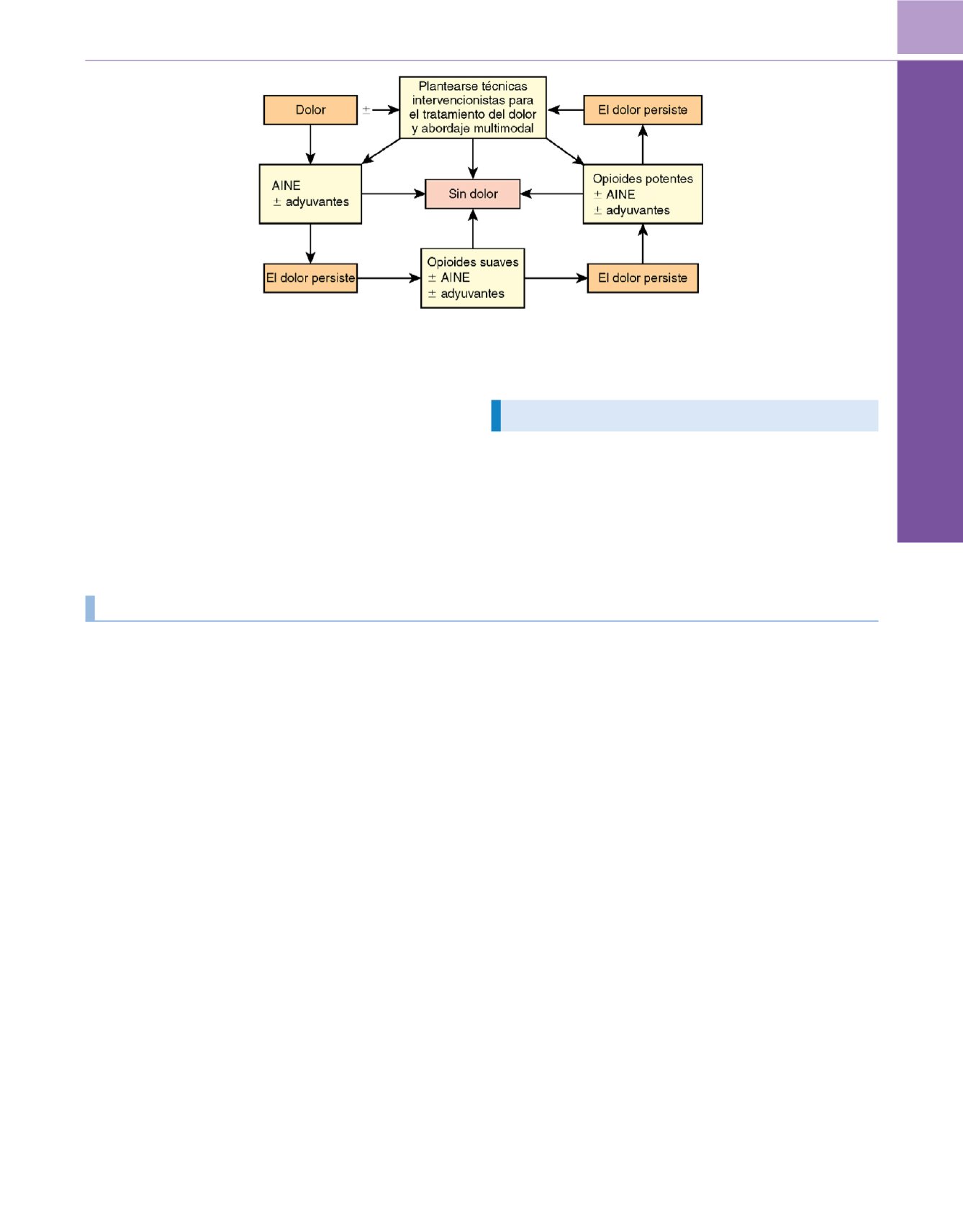

© ELSEVIER. Fotocopiar sin autorización es un delito
implantable de administración de fármacos. La metadona con fre-
cuencia es útil en pacientes con tolerancia a los opioides que tienen
dolor neuropático debido a su efecto agonista sobre los receptores
mu y su efecto antagonista sobre los receptores
N
-metil-d-aspar-
tato. Debido a la seguridad, la eficacia y la relativa facilidad de
administración intrarraquídea de los opioides para el control del
dolor intratable debido a enfermedad metastásica, cada vez se uti-
lizan más los sistemas de administración de fármacos intratecales
y epidurales implantables.
Agradecimientos
Los autores agradecen la útil contribución y experiencia de Dan
Paloski, ayudante editorial del Departamento de Anestesiología
General de la Cleveland Clinic, en la preparación de este
manuscrito.
Bibliografía
10. Mann JF: What are the short-term and long-term
consequences of anaemia in CRF patients? Nephrol
Dial Transplant 14:29–36, 1999.
11. Winearls CG: Recombinant human erythropoietin:
10 years of clinical experience. Nephrol Dial Trans-
plant 13:3-8, 1998.
12. Anderson RJ, Gambertoglio JG, Schier RW: Clinical
Use of Drugs in Renal Failure. Springfield, IL,
Charles C Thomas, 1976.
13. Prescot LF: Mechanisms of renal excretion of drugs
(with special reference to drugs used by anesthesio-
logists). Br J Anaesth 44:246, 1972.
14. Davies G, Kingswood C, Street M: Pharmacokinetics
of opioids in renal dysfunction. Clin Pharmacokinet
31:410-422, 1996.
15. Mazoit JX, Sandouk P, Scherrmann JM, Roche A:
Extrahepatic metabolism of morphine occurs in
humans. Clin Pharmacol Ther 48:613-618, 1990.
16. Schochet RB, Murray GB: Neuropsychiatric toxicity
of meperidine. J Intensive Care Med 3:246, 1988.
17. Davis PJ, Stiller RL, Cook DR: Pharmacokinetics of
sufentanil in adolescent patients with chronic renal
failure. Anesth Analg 67:268-271, 1988.
18. Chauvin M, Lebrault C, Levron JC, Duvaldestin P:
Pharmacokinetics of alfentanil in chronic renal
failure. Anesth Analg 66:53-56, 1987.
19. Davison SN: Pain in hemodialysis patients: Preva-
lence, cause, severity, and management. Am J Kidney
Dis 42:1239-1247, 2003.
20. Mazze RI: Metabolism of the inhaled anaesthetics:
Implications of enzyme induction. Br J Anaesth
56:275, 1985.
21. Cousins M, Mazze RI: Methoxyflurane nephrotoxi-
city: A study of dose response in man. JAMA
255:1611, 1973.
22. Mazze RI, Sievenpiper TS, Stevenson J: Renal effects
of enflurane and halothane in patients with abnormal
renal function. Anesthesiology 60:161, 1984.
23. Mazze RI, Cousins MJ, Barr GA: Renal effects and
metabolism of isoflurane in man. Anesthesiology
40:536, 1974.
24. Eger EI II: Stability of I-653 in soda-lime. Anesth
Analg 66:983, 1987.
25. Jones RM, Koblin DD, Cashman JN, et al: Biotrans-
formation and hepato-renal function in volunteers
after exposure to desflurane (I-653). Br J Anaesth
64:482, 1990.
26. Weiskopf RB, Eger EI II, Ionescu P, et al: Desflurane
does not produce hepatic or renal injury in human
volunteers. Anesth Analg 74:570, 1992.
27. Hanaki C, Fujii K, Mono M, Tashima T: Decomposi-
tion of sevoflurane by soda-lime. Hiroshima J Med Sci
36:61, 1987.
28. Kobayashe Y, Ochiai R, Takeda J, et al: Serum and
urinary inorganic fluride levels after prolonged inha-
lation of sevoflurane in man. Anesthesiology 75:A348,
1991.
29. Holaday DA, Smith FR: Clinical characteristics and
biotransformation of sevoflurane in healthy human
volunteers. Anesthesiology 54:100, 1981.
30. Priano LL: Effect of halothane on renal hemodyna-
mics during normovolemia and hemorrhagic hypo-
volemia. Anesthesiology 63:357, 1985.
31. Merin RG, Bernard JM, Doursout MR: Comparison of
the effects of isoflurane and desflurane on cardiovas-
cular dynamics and regional blood flow in the chroni-
cally instrumented dog. Anesthesiology74:568, 1991.
32. Cousins MJ, Greenstein LR, Hitt BA, Mazze RI:
Metabolism and renal effects of enflurane in man.
Anesthesiology 44:44, 1976.
1. Anderson KJ, Kabalin JN, Cadeddu JA: Surgical
anatomy of the retroperitoneum, kidneys, and
ureters.
En
Wein AJ, Kavoussi LR, Novick AC, Partin
AW, Peters CA (eds): Campbell-Walsh Urology, 9th
ed. Philadelphia, WB Saunders, 2007, pp 3–37.
2. Brooks JD: Anatomy of the lower urinary tract and
male genitalia.
En
Wein AJ, Kavoussi LR, Novick AC,
Partin AW, Peters CA (eds): Campbell-Walsh Urology,
9th ed. Philadelphia, WB Saunders, 2007, pp 38–77.
3. Hemmings HC Jr: Anesthesia, adjuvant drugs and
the kidney.
En
Malhotra V (ed): Anesthesia for Renal
and Genitourinary Surgery. New York, McGraw-
Hill, 1996, pp 18.
4. Kassirer JP: Clinical evaluation of kidney function-
glomerular function. N Engl J Med 285:385, 1971.
5. May RC, Mitch WE: The pathophysiology of uremia.
En
Brenner BM, Rector FC Jr (eds): The Kidney, 5th
ed. Philadelphia, WB Saunders, 1996, p 2148.
6. Bazari H: Approach to the patient with renal
disease.
En
Goldman L, Ausiello D (eds): Cecil
Textbook of Medicine, 22nd ed. Philadelphia, WB
Saunders, 2004, pp 654–662.
7. Goldman L, Bennett JC (eds): Cecil Textbook of
Medicine, 22nd ed. Philadelphia, WB Saunders,
2004.
8. Elkington JR, Huth EJ, Webster GD Jr, et al: The renal
excretion of hydrogen ion in renal tubular acidosis, I:
Quantitative assessment of the response to ammonium
chloride as an acid load. Am J Med 29:554, 1960.
9. Prough DS, Foreman AS: Anesthesia and the renal
system.
En
Barash PG, Cullen BF, Stoelting RK (eds):
Clinical Anesthesia, 2nd ed. Philadelphia, JB
Lippincott, 1992, pp 1125–1156.
Anestesia y los sistemas renal y genitourinario
1897
55
Sección IV
Anestesia por subespecialidades en el adulto
Figura 55-5
Algoritmo escalonado de la Organización Mundial de la Salud para el tratamiento del dolor. AINE, antiinflamatorios no esteroideos.









